Product Description
Dungeness Crab Clusters
Our wild caught dungeness crab may not be as well-known as the Alaska King or Snow crab, but certainly a rival in taste and texture. The Dungeness crab is the smallest of all three species but offers a distinctive sweet flavor and tender, flaky white meat. Dungeness provides a great high quality source of protein but is low in fat and calories.
How to cook Dungeness Crab Clusters
Dungeness crab is versatile and can be prepared a variety of ways: warmed up over the grill, lightly steamed or in dips and cakes! The Dungeness crab clusters are pre-cooked and can also be enjoyed cold after defrosting.
- Thaw crab legs in the refrigerator overnight.
- Preheat the oven to 350° F.
- Arrange the crab legs on the bottom of a deep glass baking dish.
- Pour ½ an inch of water into the baking dish to partially submerge the crab legs.
- Cover the baking dish with aluminum foil. Poke a few holes in the tops so that some steam can escape.
- Bake thawed crab legs for 15 minutes then remove the baking dish from the oven and serve!
Sustainably Harvested, Wild Caught, and Processed in the USA. Crab may be harvested from the following areas depending on the time of year.
Alaska: Southeast: June – November
Oregon: December 1 – August 15
Washington State: December 1 – September 15
Nutrition Information
Serving Size 3 oz (85g)
Amount Per Serving
Calories 90
Protein 19g
Fat 1g
Saturated Fat 0.1g
Cholesterol 65mg
Sodium 321mg
Total Omega-3s 501mg
*Cooked, 3 oz./ 85 g | Source: USDA Standard Reference Release 28 | Rounded per FDA guidelines
Dungeness Crab Clusters
Dungeness Crab Clusters
Couldn't load pickup availability
Product Description
Dungeness Crab Clusters
Our wild caught dungeness crab may not be as well-known as the Alaska King or Snow crab, but certainly a rival in taste and texture. The Dungeness crab is the smallest of all three species but offers a distinctive sweet flavor and tender, flaky white meat. Dungeness provides a great high quality source of protein but is low in fat and calories.
How to cook Dungeness Crab Clusters
Dungeness crab is versatile and can be prepared a variety of ways: warmed up over the grill, lightly steamed or in dips and cakes! The Dungeness crab clusters are pre-cooked and can also be enjoyed cold after defrosting.
- Thaw crab legs in the refrigerator overnight.
- Preheat the oven to 350° F.
- Arrange the crab legs on the bottom of a deep glass baking dish.
- Pour ½ an inch of water into the baking dish to partially submerge the crab legs.
- Cover the baking dish with aluminum foil. Poke a few holes in the tops so that some steam can escape.
- Bake thawed crab legs for 15 minutes then remove the baking dish from the oven and serve!
Sustainably Harvested, Wild Caught, and Processed in the USA. Crab may be harvested from the following areas depending on the time of year.
Alaska: Southeast: June – November
Oregon: December 1 – August 15
Washington State: December 1 – September 15
Nutrition Information
Serving Size 3 oz (85g)
Amount Per Serving
Calories 90
Protein 19g
Fat 1g
Saturated Fat 0.1g
Cholesterol 65mg
Sodium 321mg
Total Omega-3s 501mg
*Cooked, 3 oz./ 85 g | Source: USDA Standard Reference Release 28 | Rounded per FDA guidelines

Frequently Asked Questions
How will I receive my product?
Items are shipped in an insulated box with dry ice to keep items frozen until they reach your home. All orders are shipped via FedEx unless another carrier is requested by the customer. You will be emailed the tracking information as soon as the order ships. Please allow until 8PM for updated information from FedEx.
How is the fish packaged?
All products are Individually vacuum-sealed in BPA-free plastic.
What does “Sustainably Harvested” mean?
For sockeye salmon, the Alaska State Department of Fish and Game monitors all commercial, sport, and residential salmon fishing. This means a set number of permits are sold each season based on predictions of the number of salmon expected to return to spawn. As the salmon move towards the bay, researchers actively monitor their movement and count the number of salmon in each school. They then use this data to determine when the fishermen are allowed to fish, if the volume of salmon is too low they are not allowed to fish. Once the volume rises to a number which allows for enough fish to escape upstream to spawn, the fishermen are given a set amount of time that they are allowed to fish. This timed fishing allowance and escapement number is vital to the sustainability of salmon.
How should I store my seafood?
We guarantee the quality of our products to be maintained for one year from purchase when kept in proper conditions. All seafood should be kept in a freezer that maintains even temperature, do not store any seafood on the door or towards the front of the freezer, and do not stack other items on top of seafood. If your seafood loses its vacuum seal, plan to use those pieces first! They are still completely safe to eat but are more prone to freezer burn. Freezer burn is the process of water being pulled from the fish and turned into ice crystals.




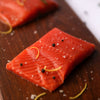 Wild Alaska Salmon
Wild Alaska Salmon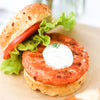 Alaska Salmon Burgers
Alaska Salmon Burgers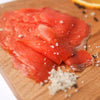 Smoked Salmon & Seafood
Smoked Salmon & Seafood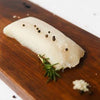 Wild Alaska Whitefish
Wild Alaska Whitefish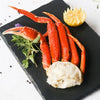 Wild Shellfish & Shrimp
Wild Shellfish & Shrimp Wild Albacore Tuna
Wild Albacore Tuna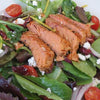 Canned Seafood
Canned Seafood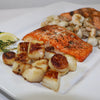 Meal Box & Samplers
Meal Box & Samplers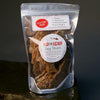 Pet Products
Pet Products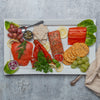 Gifts
Gifts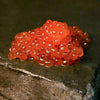 Specialty
Specialty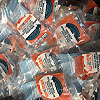 Wholesale Ordering
Wholesale Ordering



